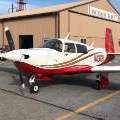I've been making some recent efforts to look for ways to optimize max speed in my 201. Still can't get close to book numbers.
Then while talking to someone about a speed test flight I did today, he caught on to something. I pointed out that today was a very close to standard sort of day and yet the max MP I was getting came shy of POH power table values. I explained how I was getting 22" MP at 7,500 while the book was giving figures based on 23.6". I originally figured it was just the conditions or I wasn't developing max available MP (even with ram air open).
Well based on the 1" per 1000ft rule of thumb and more specifically looking up a table, I discovered that the POH inflate available MP substantially for the max power settings and that has a bit to do with why I'm not attaining book value speeds. So while standard pressure at 8,000ft should be 22.225 inHG, the Mooney POH gives a 75% power setting based on 23.6" at the same standard temperature of -1C. Where the heck are they getting this number from? How is this supposed to be useful to me when it is inflated over 1.3"?
I checked for other altitudes and the error was not constant so I don't think it is expected boost as the result of ram air. I also looked at power tables for other airplanes and they tend to have a more standard MP value relative to altitude. Anyone know what this is about? Is the error strictly limited to the MP value or are the %power and speeds derived based on that exact MP? Does this mean that 75% is actually impossible above 6,500ft under standard conditions?


